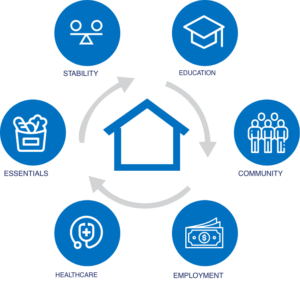AFFORDABLE HOUSING IS HOUSING THAT A HOUSEHOLD CAN PAY FOR, WHILE STILL HAVING MONEY LEFT OVER FOR OTHER NECESSITIES LIKE FOOD, TRANSPORTATION AND HEALTH CARE.

HOW DOES AFFORDABLE HOUSING DIFFER FROM PUBLIC HOUSING?
Affordable Housing and Public Housing are two distinctly different concepts that are confused with one another. While both address housing affordability issues, they differ greatly in their underlying financial structures and implementation. While Public Housing is Affordable, Affordable (or “LIHTC”) Housing is not Public Housing.
Public housing in Rockford is provided by Rockford Housing Authority and NIReACH (formerly known as Winnebago County Housing Authority). Both organizations operate government-owned housing units that are reserved for the lowest-income households and provide subsidized rents to eligible individuals. These public housing institutions have played crucial roles in providing free or heavily subsidized housing for the extremely low-income, disabled and/or elderly individuals and families in our community for decades. Unfortunately, Public Housing has been associated with challenges such as insufficient funding, limited resources for maintenance, the stigmas that come with concentrated poverty and social isolation and the inevitable negative effects of low-income communities being isolated from economically sustainable neighborhoods and the opportunities they hold.
BENEFITS FROM AFFORDABLE HOUSING

The term Affordable Housing is different. It refers to housing units and programs designed to be affordable for working people and families who find themselves in low and moderately low-income brackets. If a working person or his/her family is forced to spend more than 30% of their annual income on housing, they are deemed to be cost burdened and eligible for affordable housing assistance. Those spending more than 50% of their income are considered severely cost burdened. Making housing affordable for such households is achieved through various mechanisms such as equity programs, tax incentives and inclusionary zoning.
Affordable Housing encompasses a broad spectrum of initiatives that foster housing affordability within the private market. This can include rental assistance programs, tax credits for companies and/or individuals purchased from developers who build affordable units or regulations that require developers to set aside a portion of units as affordable.
The primary objective of Affordable Housing is to create a balanced housing market that provides options for individuals and families across all income levels, allowing them to choose housing that suits their needs without solely relying on government-owned properties or compromising their ability to lead healthy lives.
Affordable housing encourages diversity and inclusivity, as it integrates affordable units within mixed-income developments, thereby reducing concentrations of poverty.
Affordable Housing does not drive down nearby property values. To the contrary, Affordable Housing has been shown to raise adjoining property values and enhance community quality of life.
By understanding the differences between the Public Housing and Affordable Housing, private developers, elected officials and policymakers can develop smart, comprehensive housing strategies that blend affordability, diversity, and inclusivity to meet the diverse needs of communities like ours.
